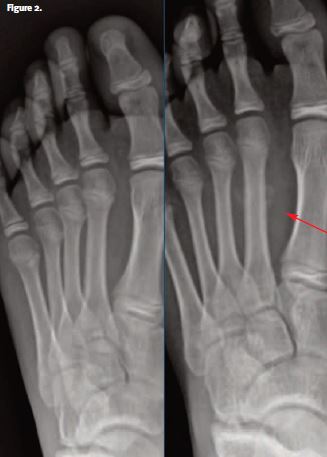Published on

Differential Diagnosis
- Occult second metatarsal fracture
- Peroneal tendon injuries
- Sesamoiditis
- Plantar fascia ruptures
Diagnosis
Initial imaging is unremarkable. However, the second image reveals focal periostitis at distal second metatarsal consistent with occult fracture.
Learnings/What to Look for
- The first metatarsal is most commonly fractured in children less than 4 years old, while the fifth metatarsal is the most commonly fractured in adults
- Third metatarsal fractures rarely occur in isolation; 68% are associated with fracture of second or fourth metatarsal
- Crush-type and direct-blow injuries are infrequently associated with pediatric foot fractures. The more common mechanism of metacarpal fracture is from a fall or foot inversion
- Direct blow injuries may be more associated with occult osseous injuries from compressive forces of adjacent bones against one another or by traction forces during an avulsion injury
Pearls for Urgent Care Management
- In the absence of Lisfranc injury, nondisplaced fractures of the first through fourth metatarsal can be managed initially with splinting and non-weightbearing, followed by application of a short leg cast and continued non-weightbearing
- In the absence of obvious findings on initial radiograph, patients should receive instructions to follow-up with orthopedics or sports medicine to evaluate for occult fractures if there is not significant improvement in pain and swelling in one week.
Acknowledgment: Case and images provided by Experity Teleradiology (www.experity.com/radiology).
A 12-Year-Old Boy with a Crush Injury
1 2
